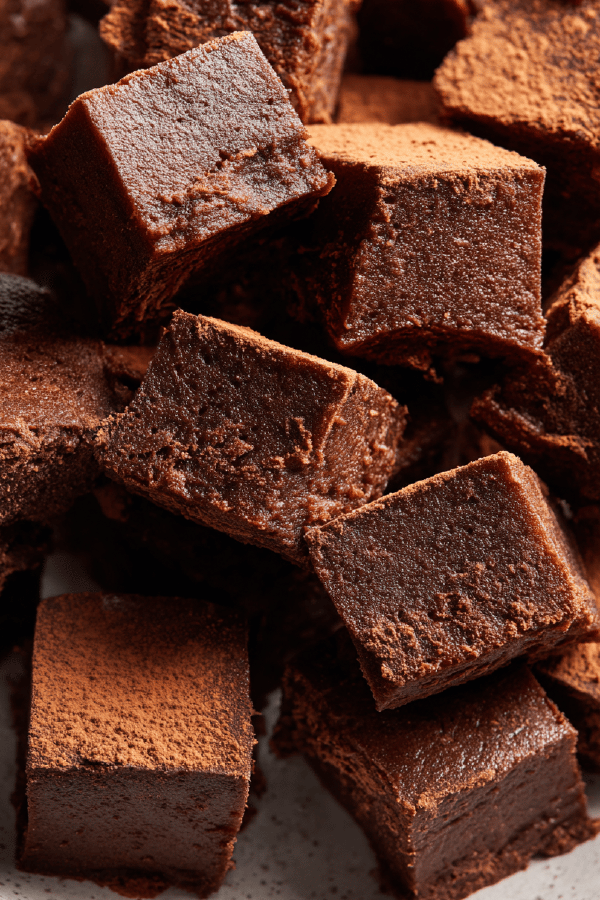Featured Recipe
Mini fudge squares

By Kate
"
Small bite-size chocolate treats blending semi-sweet chocolate with creamy butter, light brown sugar, eggs, and a hint of espresso powder for depth. Fluffiness managed by careful whisking of eggs and gradual folding of dry ingredients balanced with whole milk. Oven set hotter for a shorter bake to lock moisture without overcooking. Result is moist, tender edges, moist soft centers, easy to portion. Swap whole milk for oat milk, use coconut sugar instead of brown sugar, and toss in chopped crystallized ginger for punch. Developed for reliable texture, quick baking, and simple assembly.
"
Prep:
20 min
Cook:
18 min
Total:
38 min
Serves:
36 pieces
dessert
baking
chocolate
easy recipes
Introduction
Start with melting the chocolate. Not too hot or cold. Air bubbles steal shine and texture. Butter’s softness vital; if too hard, sugar won’t cream well—spotty crumb trouble. Brown sugar adds moisture. Eggs bind, leaven, bring structure. Folding flour alternated with milk stops batter becoming gluey; keeps lightness while holding moisture. Chocolate folded last, temperature important. Muffin pans sized well for bite-sized treats but overfill and you’ll get flat discs, not cake-like squares. Oven temperature key. If too low, runny—too high, burnt edges. Watch visual cues, gentle wobble in center, chocolate aroma changing from raw to baked. Espresso? Optional but wakes up deep cocoa notes. Swap coconut sugar for less caramelized flavor or try oat milk for dairy-free option, expect slight texture change. A few rough edges stand for kitchen reality but this method gets you reliably tender, moist brownies without fuss.
Ingredients
About the ingredients
Use quality chocolate with at least 60% cocoa solids for rich flavor and good melting behavior. Butter shouldn’t be melted but softened; cold butter won’t cream well with sugar, leading to dense brownies. Light brown sugar balances moisture with sweetness. Espresso powder optional but skews flavor towards complex bittersweet rather than flat cocoa. Flour must be sifted to avoid lumps; all-purpose is fine but cake flour could soften edges more. Milk adds moisture and tenderness but whole milk or full fat plant milk gives best result. Egg freshness matters for proper rise and structure. Salt brightens chocolate notes and balances sugar. Experiment swapping coconut sugar for light brown sugar to reduce moisture—expect fudgier texture but slight dryness risk. Oat milk a straight swap for milk, less fat, may alter mouthfeel marginally. Chopping chocolate unevenly allows melting at different rates preventing scorching.
Method
Technique Tips
Temperature control is king. Melting chocolate over gentle simmer avoids scorching or water contamination—both kill texture. Watch for glossy sheen on melted chocolate before mixing. Butter and sugar creaming traps air for rise—don’t shortcut this step or brownies feel heavy. Whisk eggs slowly into butter mixture to avoid curdling but ensure thorough integration. Flour folded in increments with milk keeps batter balanced—too much flour at once, you lose tenderness. Folding preserves delicate crumb, don’t overstir or creaminess disappears. When mixing in chocolate, fold gently but fully; chocolate temperature close to batter avoids premature solidifying or streaking. Use tapping trick before baking to remove air pockets to avoid holes or tunnels. Oven hotter than usual, 190 °C, bakes brownies faster; watch wobble and firming edges for doneness. Underbaking yields sticky, overbaking brittle. Rest before unmolding; hot brownies collapse in tin. Store airtight to keep moist. Easy batch method yields consistent results from imperfect kitchens.
Chef's Notes
- 💡 Chop chocolate unevenly—helps it melt at varied rates. Avoid scorching. Check for glossy sheen when melted. Make sure it cools slightly. Adds great texture.
- 💡 Watch butter—not too soft or hard. Room temp is key—cream well with sugar. Should be fluffy, light. This ensures air traps nicely.
- 💡 Eggs? Don’t beat too hard; whisk slowly to avoid curdling. Integrate them well with sugar mix or you’ll get a dense final product.
- 💡 Sifting flour is essential to avoid lumps. Be gentle while folding, careful not to overmix or batter loses tenderness. It should be light.
- 💡 Baking time? Check edges first. Firm but slightly quiver in the middle signals done. Don't pull out too soon; leads to gooey centers.
Kitchen Wisdom
What if the brownies don’t rise?
Likely due to overmixing. Fold gently. Don’t trap too much air. Or maybe eggs weren’t fresh.
How to store fudge squares?
Keep in airtight container. Fridge is okay but not too cold. Room temp works well to maintain texture.
Can I swap ingredients?
Yes, oat milk for dairy, coconut sugar can replace brown sugar. Note: Texture may shift a bit.
Common issue with baking?
If too dry, oven might be too hot or baked too long. Try reducing time; check visual cues for doneness.



